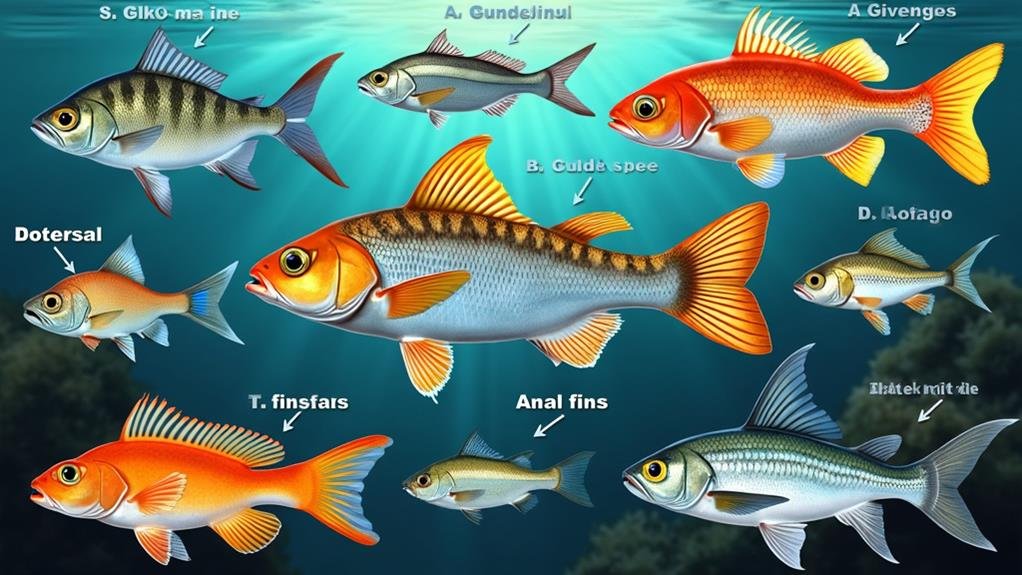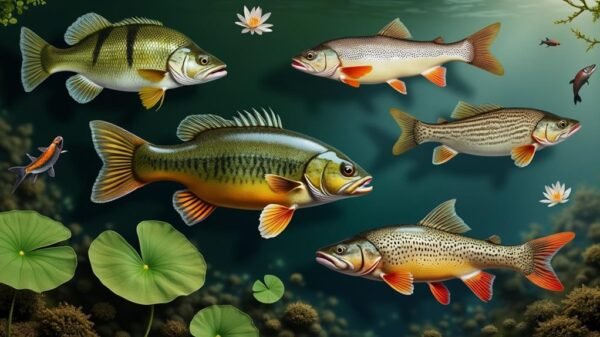To quickly recognize freshwater fish, start by understanding common species and their habitats. Observe color patterns and distinct markings like stripes or spots, as these are key identifiers. Pay attention to body shapes—different species vary greatly! Check fin placement and shapes; these details can reveal much about a fish's identity. Utilize field guides for images and descriptions, and don't hesitate to join local fishing clubs for hands-on learning. Flashcards can reinforce your knowledge too. By combining these tips and practicing regularly, you'll boost your skills. Stay tuned to uncover more secrets to fish identification!
Understand Common Species
To begin your journey in identifying freshwater fish, it's essential to recognize common species found in different environments. Each aquatic habitat, from serene lakes to winding rivers, hosts distinct fish types. For example, the bluegill, known for its round body and vivid colors, is a common sight in ponds and lakes. In river systems, the catfish can be spotted, characterized by its whisker-like barbels that assist in navigating murky waters. Additionally, the delectable catfish, often featured in southern recipes, delights with its sweet taste. As you wander further, the rainbow trout will catch your eye with its brilliant patterns, typically residing in cold, clear streams. Don't forget the bass, a strong contender among anglers, valued for its robust physique and assertive behavior. Recognizing these species enriches your appreciation for aquatic life.
Your adventure into fish identification will enhance your connection with the natural world, providing a sense of freedom and excitement. Equip yourself, remain alert to your environment, and let the joy of discovery lead you as you embrace the wonders of freshwater ecosystems.
Observe Color Patterns

When you're out fishing or just observing, pay close attention to the color patterns of the fish you see. Different species come with unique hues and distinct markings that can help you identify them. For instance, using lifelike lures like the ones offered by TRUSCEND can enrich your fishing experience, as these lures are designed with realistic colors and patterns that mimic actual fish (TRUSCEND Fishing Lures). Noticing these details can turn your experience into a fun and educational adventure
Identify Species by Hue
Color patterns significantly aid in distinguishing freshwater fish species. Each species showcases distinct hues and markings. When by the water, observe the fish's coloration. Some species exhibit vibrant shades such as blue, green, and yellow, while others appear more subdued in tones of brown and grey. These colors may vary based on the fish's environment and emotional state. For instance, warm-water species like the bluegill often display bright colors, helping to differentiate them from others. Explore resources on various fishing techniques to understand how color patterns indicate specific behaviors.
Take the male Betta fish, renowned for its striking red, as a clear species identifier. Similarly, the iridescent scales of the Rainbow Trout, a popular catch, make it easily recognizable. Familiarizing yourself with the common color patterns of local fish species is crucial. Utilize research tools or apps that specialize in fish identification by hue.
When identifying a fish, concentrate on its overall tone and shade. Is it vibrant and eye-catching, or subtle and blended with its surroundings? This careful observation can greatly enhance your ability to accurately determine the species in sight. So, venture outside, revel in nature's beauty, and let the colors lead your exploration.
Notice Distinct Markings
Distinct markings are crucial for recognizing freshwater fish species, acting as unique identifiers. While fishing or exploring rivers, pay attention to these characteristics. Patterns such as stripes, spots, or swirls reveal much about the fish you encounter. For instance, employing various fishing techniques can enhance your ability to identify species like the Lepomis macrochirus (common bluegill) or Pomoxis nigromaculatus (crappie).
The bright spots on a Salvelinus fontinalis (brook trout) make it easily identifiable, while the lateral stripes on a Micropterus species (bass) help differentiate it from other similar fish. Additionally, examine the fins and tails; these features can exhibit distinct shapes and colors that aid in identification.
While color provides hints, it's the blend of color and markings that refines your options. Keep a field guide, such as the "Freshwater Fish of North America," handy to compare your catches. With practice, you'll enhance your observational skills, turning fish identification into an enjoyable pursuit.
Examine Body Shapes

Body shape significantly aids in identifying freshwater fish, as various species display distinct silhouettes. When you're fishing, take a moment to observe the fish you see. Are they elongated and slender, resembling a Northern Pike, or more rounded, akin to a Bluegill? Each silhouette provides insight into their behaviors and habitats, illustrating how different fish species inhabit lakes and ponds and vary in form according to their surroundings.
For example, flat-bodied species like the Channel Catfish are adapted for navigating through narrow spaces in riverbeds, while streamlined fish such as Rainbow Trout excel in swift swimming across open waters.
Additionally, consider the girth of the fish. A robust form often indicates a healthy predator, whereas a sleeker shape may suggest a fish built for speed.
Examine the overall proportions, too. Some fish exhibit a compressed shape, while others are deeper-bodied. These variations can assist you in narrowing down the species you observe.
Note Fin Placement

When you're trying to identify freshwater fish, fin placement can be a game changer. Different species exhibit unique fin structures, and understanding these differences can improve your identification skills. Moreover, resources like Freshwater Fish Identification can provide you with detailed information on different fish types. Pay close attention to the shapes and positions of the fins, as these characteristics can vary widely between species. Furthermore, don't forget to note the colors of the fins, since they often provide important clues for accurate recognition.
Types of Fin Shapes
Fins serve an essential function in recognizing freshwater fish, and understanding their shapes can simplify identification. For example, identifying species such as the Largemouth Bass can enhance your fishing experience. Observing fins reveals various shapes, each providing insights into the fish's identity and behavior.
Here are some common fin shapes to observe:
- Lanceolate Fins: These long, narrow fins assist fish like the Northern Pike in maneuvering quickly through water.
- Rounded Fins: Present in species like the Channel Catfish, these fins offer stability for swimming in multiple directions.
- Forked Fins: Typically found in species such as the Smallmouth Bass, forked fins enhance speed, allowing them to effectively catch prey.
- Triangular Fins: Common among fish like the Freshwater Angelfish, these fins facilitate sharp turns and rapid movements.
- Fan-shaped Fins: Seen in species like the Common Goldfish, these fins provide elegance and balance during slow swimming.
Fin Position Differences
The position of fins on a freshwater fish reveals much about its swimming style and behavior. Fish with front-positioned fins, like pectoral fins, tend to be more agile and capable of making quick turns. This agility aids them in navigating tight spaces in their habitats, such as rivers or lakes. Understanding diverse fishing methods, like fly fishing or baitcasting, enhances your ability to identify how fish adapt to their environments. Conversely, fish with fins positioned towards the back, such as dorsal and anal fins, are often designed for speed, allowing them to glide effortlessly through the water.
The tail fin also plays a critical role. A forked tail indicates a fish capable of rapid bursts of speed, while a rounded tail suggests a more leisurely swimmer. Observing these fin arrangements provides insight into how fish interact with their ecosystems and evade predators.
Pelvic fins are equally important, as their positioning can affect a fish's stability and maneuverability in varying water conditions. By closely examining fin placements, you will begin to recognize patterns that assist in identifying different species. So the next time you find yourself by a river or lake, take a moment to appreciate these remarkable adaptations. Understanding fish behavior can lead to exciting new discoveries in the world of aquatic life.
Identifying Fin Colors
Recognizing fin colors can significantly enhance your ability to identify various freshwater fish species. Each species possesses unique fin colors, which serve as visual indicators for identification. For instance, identifying the bright fin colors can improve your chances of catching species like the Oncorhynchus mykiss, commonly known as the rainbow trout, in coldwater habitats. Focus on the vivid shades and patterns on their fins, as these can differ widely among species.
Here are some tips to enhance your fin color recognition abilities:
- Observe the dorsal fin: This fin is typically the most noticeable, often showcasing striking colors.
- Check the pectoral fins: These fins can display vibrant colors or intricate patterns, aiding in species differentiation.
- Look at the caudal fin: The coloration of the tail fin can provide insights into a fish's environment and behavior.
- Examine the anal fin: This fin may exhibit distinctive hues that help in distinguishing closely related species.
- Consider the context: Take note of the overall body color, as it can assist in understanding how fin colors integrate into the broader visual context.
Study Habitat Preferences

Understanding the habitat preferences of freshwater fish is essential for effective identification. When you delve into the realm of aquatic species, you'll discover that various types flourish in distinct environments. Some fish, such as bluegills, thrive in calm lakes, while others, like trout, prefer the brisk flow of rivers. By observing the locations where fish congregate, you can swiftly recognize them. For instance, specialized fishing techniques, such as fly fishing for trout or bottom fishing for catfish, can be utilized depending on whether you're targeting species in lakes or rivers.
Take a moment to analyze the environment. Search for natural structures like boulders, aquatic plants, or submerged logs; these often provide shelter. Species such as bluegills favor shallow areas rich in vegetation, while catfish typically reside in deeper, murky waters. Recognizing these preferences can significantly enhance your ability to locate them.
Consider the thermal properties of the water as well. Certain species, like rainbow trout, flourish in cooler streams, whereas others, such as largemouth bass, are more comfortable in warmer conditions. Grasping these nuances aids in predicting where to find particular species.
Seasonal changes also play a role! Fish behavior varies with climatic shifts. In spring, many species migrate into shallower waters for spawning, presenting an excellent opportunity for observation. By understanding their habitat preferences, you'll not only sharpen your identification skills but also elevate your fishing experiences.
Utilize Field Guides

Dive into the realm of freshwater fish identification by using specialized field guides, essential resources for both novice and expert anglers. These guides offer comprehensive descriptions, vivid photographs, and crucial identification characteristics that simplify recognizing various species. Additionally, exploring the variety of freshwater fish, from invasive species like Asian carp that threaten ecosystems to popular targets such as largemouth bass, can enhance your understanding. With a field guide at your side, you can strengthen your bond with nature and confidently identify the fish you discover.
Here are five tips to maximize your field guide experience:
- Select a Region-Specific Guide: Opt for a guide focused on your geographic area to ensure you are viewing pertinent species.
- Learn Key Characteristics: Pay attention to colors, patterns, and body shapes that differentiate each fish.
- Utilize the Index: Efficiently find species by referencing the alphabetical index or a visual identification chart.
- Document Your Findings: Record observations or capture images of the fish you encounter to solidify your knowledge.
- Engage with a Community: Connect with other anglers or fish enthusiasts who can share valuable insights and experiences.
With the right field guide, you will become absorbed in the captivating world of freshwater fish, eager to discover all it has to offer.
Practice Regularly

Regular practice is crucial for mastering the identification of freshwater fish and improving your expertise. The more you encounter various species, the simpler it becomes to recognize them. Begin by frequenting nearby bodies of water, such as Lake Michigan or the Mississippi River, as these sites often feature a range of common freshwater species like bass, trout, and catfish. On each outing, take time to observe and document the fish you observe. Utilize a field guide, such as the Peterson Field Guide to Freshwater Fishes, to aid in learning their names and characteristics.
After some time, attempt to identify fish without referring to your guide. Challenge yourself! You'll discover that the shapes, colors, and patterns begin to resonate in your memory. Consider joining local fishing clubs or online platforms like Fishbrain. Sharing your encounters with fellow enthusiasts can enhance your knowledge and maintain your motivation.
You might also create flashcards featuring images of various fish on one side and their names on the opposite. Test your recall or have a friend quiz you. This can be an enjoyable method to reinforce your learning. Remember, consistency is key! The more you engage in this practice, the more assured you'll become. Dive into this adventure with passion, and soon you'll be identifying freshwater fish effortlessly, relishing every moment spent by the water.



























